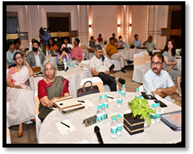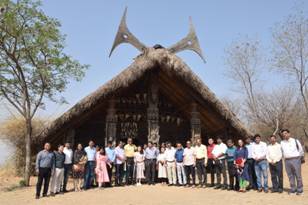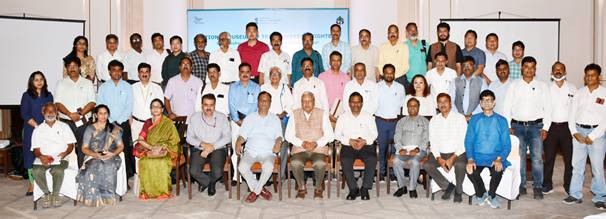New Delhi : A two-day national workshop (7th and 8th April 2022) was organised at Bhopal, Madhya Pradeshby the Development Support Agency of Gujarat (DSAG), Tribal Development Department of Gujrat and Ministry of Tribal Affairs, Government of India. More than fifty experts comprising of historians and researchers associated with tribal history, anthropologists, filmmakers, curators, artistsand expert associated with development of museumhad detailed discussion with directors and representatives of Tribal research Institutes of different states where tribal museums are being set up.
On 15th August 2016, in his Independence Day speech at Red Fort, Prime Minister, Shri Narendra Modi, had announced to establish tribal freedom fighters’ museums to acknowledge thecontributions of tribal unsung heroes to the national freedom movement. Consequently, Ministry of Tribal Affairs has sanctioned ten Tribal Freedom Fighter museums to be located in Gujarat, Jharkhand, Andhra Pradesh, Chhattisgarh, Kerala, Madhya Pradesh, Telangana, Manipur, Mizoram and Goa. On 15th November 2021 on Janjatiya Gaurav Diwas, BhagwanBiswa Munda Tribal Freedom Fighter Museum in Jharkhand was dedicated to the nation by PM, Shri Narendra Modi. The museum being set up at Gurudeshwar in Narmada District would be the National Museum where in 16 major Gallaries will be dedicated to tribal freedom movements across India. The museum under construction is about 6 km from statue of Unity.
Since 2017, there have been 13 National Level Committee meetings which have given their recommendations on the civil and curational aspect of these museums. TheNational Level Committee (NLC) had met last time at Garudeshwar where Secretary Ministry of Tribal Affairs and Secretary, Ministry of Culture, New Delhi, and experts from different areas had given suggestions for the national museum. Consequent to recommendations of the NLS, the workshop at Bhopal was organised.
Dr Navaljit Kapoor, Joint Secretary, Ministry of Tribal Affairs, presented an overview of the ten freedom fighters’ museums. He suggested that drafting a written SOP (Standard operating procedure) for all upcoming tribal museums and mechanism to get the content vetted and the curation in sync with tribal culture to be developed in association with tribal communities as suggested by NLC. He also shared the agenda based on the recommendation of NLC meetings and the expected outcomes of the two-day workshop.
Pr Secretary Gujarar Sh. Murli Krishna and Ms Pallavi Jain Pr Secretary, MP shared their experiences in development of museums at Gujarat, and Chindwara in MP.



In the workshop, discussion took place on key issues related to development of content and storyline of each tribal movement. The architectural design isto be in sync with whole theme / storyline. Thread bare discussions were held with each State to acquaint & align them with ground realities, authenticity & actual importance of content, ensure proper convergence of knowledge, resources &expertise, leveraging of technology corresponding to international standards; concurrent upgradation of technology and landscaping of area required with focus on storyline in sync with architecture were also areas of discussion. 5 regional committees were formed with experts from different fields who will help developing and approving the Content Development and Search cum Selection of artefacts, identify artisans and material to expedite the curatorial planning and execution of the project. There were intense discussion with experts about the various aspects of the museum and different points of views with regard to content, curation and civil structure. The experts gave various recommendations.


Many experts from different backgrounds had associations with RashtriyaManavSangrahalaya (RMS), Bhopal. The participants also visited RMS who have linkages with curational artists across India. The experts from RMS offered to provide their expertise and services in development of these museums and it was suggested that expertise available with of RMS should be suitably utilized.
Dr Kalyan Kumar Chakraborty, Expert Advisor to the NLC, emphasized the creation of a digital archive, including continuously changing narrative, offsite display, involvement of representatives from the tribal communities, and ideas of sustainability and retribalization of the museum.
Prof.AmreshwarGalla, UNESCO Chair and expert on museums with profound international experience in the field of museums, suggested focusing on capacity building, establishing a national framework for the museum, and inclusion of multiple voices and perspectives in the museum. He also emphasized the drafting of baseline policies and structures for the effective implementation of the project.
Shri Sanjay Prasad, Ex-ACS and currently State Election Commissioner, suggested being careful in choosing a narrative as most of the tribal documentation echo a colonial perspective.

Sh. Neetiraj, Director TRI MP, Sh. AB Ota, Director TRI Odisha, Sh. Ranendra Kumar, Director TRI Jharkhand and Ms ShamiAbidi, Director TRI Chattisgarh discussed about the museums in their states. As most of tribal movements have happened in these states and most of the material available is documented by either the British or based on oral history, folklores and stories, they emphasised how the veracity of the content related to tribal movements needs to be verified through community leaders and vetted by historians working on tribal history.
Ms MeeraDass, an independent architect and planning professional, suggested involving the tribal voice in the museum by involving members from the respective tribes. Dr Vinay Kumar, Department of Ancient History, BHU Varanasi, Sh. Chandi Prasad, School of Humanities, National Rail and Transportation Institute, Vadodra,
Dr Sarit Chaudhary, Dr SB Ota, the Ex-directors of IGRMS shared their experiences and offered to provide expert advise to respective TRIs in content development, search and selection of artists and artefacts.
Prof. Subhadra Channa, University of Delhi, also emphasized foregrounding tribal voices in the museum, presenting multiple authors’ perspectives in a narrative, and keeping the museum space organic and evolving. Further, she discussed the idea of a ‘sacred space’ and proving multisensory exposure to visitors, such as the use of the smell of forests and tribal food and tribal songs in the galleries.
Dr K K Mishra, an anthropologist, academician, and ex-director of IGRMS, Former Vice-Chancellor, Utkal University of Culture, Bhubaneswar suggested laying special emphasis on narrative and community involvement. He also mentioned that the representation of the tribal freedom movement must be concerning time and space. The storyline needs to be exhaustively studied before being showcased in the museum.
It was decided to have regional workshop so that the learnings from the workshops and progress of different museums could be monitored in line with the discussion during the workshop.

Comments are closed.